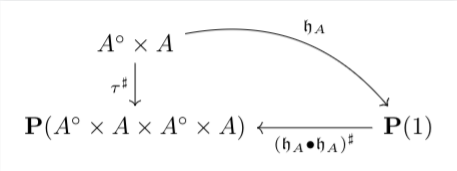$\def\K{\mathcal K}$ Preamble.
Given a locally small category $\mathcal K$, its "composition law" is a class of maps $$ c_{abc} : \K(a,b)\times\K(b,c)\to \K(a,c) $$ with the universal property of an initial cowedge.
This means that there is a cowedge $\gamma_{bb'} : \K(a,b)\times\K(b',c)\to \K(a,c)$ whose coend $\int^{b\in\K}$ is $\K(a,c)$.
In hindsight this is pretty obvious: I'm evaluating the composition $\hom\,\bullet\,\hom$ of the identity profunctor with itself, on the objects $(a,c)$.
Now, this situation seems ready to be formalized.
The setting.
Assume $\K$ has a "representable" Yoneda structure, i.e. that $A\mapsto [A°,\Omega]$ is a presheaf construction on $\K$ (this happens e.g. when a Yoneda structure is "good", but I don't need this assumption, and in particular I'm not asking that $\Omega$ classifies opfibrations). It turns out that if $1$ and $1\amalg 1$ are admissible, $\Omega\cong {\bf P}(1)$, and (assuming the existence of a right adjoint for the folding map ${\bf P}(1 \to 1\amalg 1)$ the object $\Omega$ becomes a monoid in $\K$.
So, when $A$ runs over the class of admissibles of the Yoneda structure, we get a bunch of maps $$ \mathfrak h_A : A°\times A\to {\bf P}(1) $$ obtained as mates of the Yoneda embeddings $y_A : A\to {\bf P}(A)$, and a monoid structure $\bullet : {\bf P}(1)\times{\bf P}(1)\to {\bf P}(1)$.
The question.
how far the $\mathfrak h_A$'s are from having the same universal property of the hom cowedge $\gamma$?
In order to answer this question, keep in mind that
- Coends are hom-weigthed colimits, in the sense that $\int T \cong \hom_{\K}\otimes T$ for a functor $T : \K^\text{op}\times \K\to \mathcal D$.
- In a Yoneda structure the weighted colimit of $f : A \to B$ by a weight $w : S \to {\bf P}A$ is a $w$-relative left adjoint to $f^\sharp = \text{Lan}_f(y_A)$, or in other words an absolute left lifting of $w$ along $f^\sharp$.
In view of this, I propose that the following theorem holds in a 2-category $\K$ with the above structure:
The mates $\mathfrak h_A$ of the Yoneda embeddings exhibit the same universal property of the absolute left lifting of $\tau^\sharp$ along $(\mathfrak h_A\bullet\mathfrak h_A)^\sharp$ in the diagram
where
- $\tau : A°\times A\times A°\times A \to A°\times A$ "forgets the central two coordinates" and
- $\mathfrak h_A\bullet\mathfrak h_A : A°\times A\times A°\times A \xrightarrow{\mathfrak h_A\times\mathfrak h_A} {\bf P}(1)\times{\bf P}(1)\xrightarrow{\bullet} {\bf P}(1)$
I am, however, unable to find a proof for this statement, and I'm asking suggestions (or a reason why I shouldn't expect this to be true).

